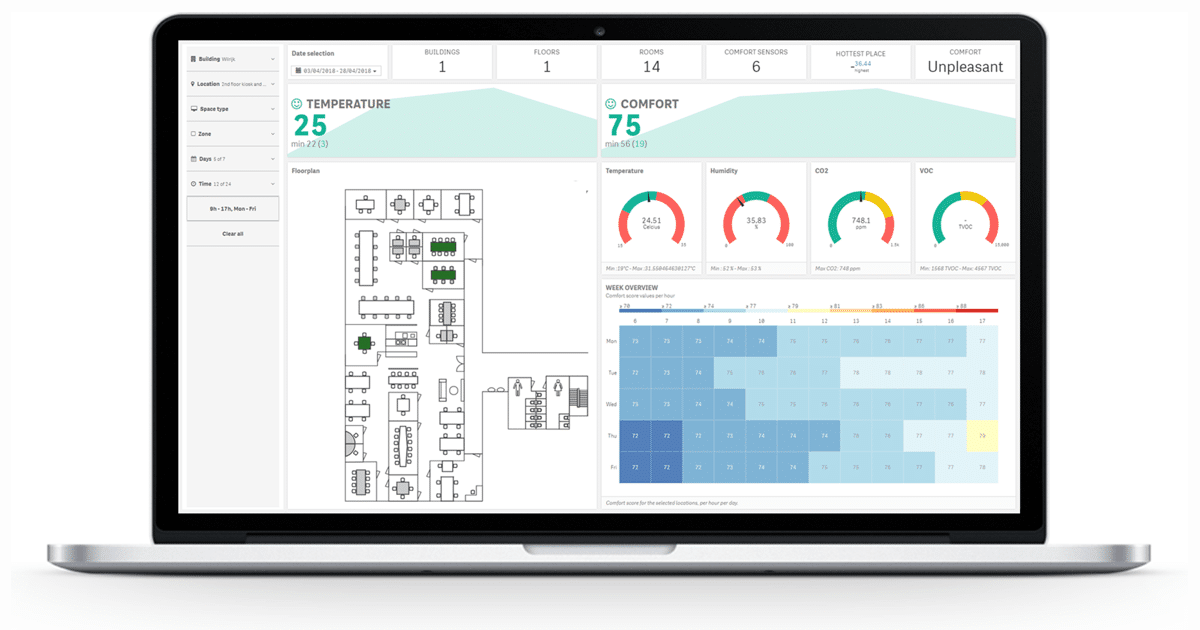The COVID-19 public health crisis has moved cleaning protocols front and center for building operations. Yet, in addition to cleaning, we are seeing a growing emphasis on overall human wellbeing. Beyond supporting a happier, more resilient workforce, building wellness can enhance the office as a destination and even drive business gains. What makes building wellness so attractive? It’s that, unlike corporate wellness initiatives that have historically faced selection problems or have had difficulty showing long-term impact1, healthy buildings can help all occupants, often without requiring any conscious effort.
What makes a “healthy building”? The Harvard T.H. Chan School of Public Health has identified nine foundational aspects of a healthy building: ventilation, air quality, water quality, thermal health, dust and pests, lighting and views, noise, moisture, safety, and security2. Other elements of healthy building design can include interior fit-outs that promote fitness, biophilia, and social wellbeing.3
Buildings and Wellness
One significant reason to focus on buildings as a component of health and wellness is that human beings spend most of their life indoors. The U.S. EPA reports that Americans, for instance, spend approximately 90% of their time indoors4. Exposure to indoor pollutants can produce a wide range of adverse health outcomes, from headaches or asthma to cancer. Because of the amount of time we spend indoors, people are even exposed to more outdoor pollutants while inside buildings than they are outside5. Promoting healthy indoor environments through ventilation and continuous monitoring of indoor environmental quality (IEQ) – which can mitigate those health risks – can have long-term benefits for occupant health.
These effects also extend to the current public health crisis. Research suggests that the stability of viruses, including SARS-CoV-2, is sensitive to temperature and humidity6. Humidity at the extremes and low temperatures can slow the rate of viral decay (and thereby increase the risk of transmission), so controlling the indoor environment can be an important component of public health.
Beyond those effects, we also know that buildings with good ventilation and air quality can yield strong business returns. Indoor air quality has been linked to enhanced cognitive function, reduced absenteeism, and even lower risk of disease transmission. The resulting productivity gains – particularly in knowledge industries – far outweigh the increased cost of utilities, even in the absence of investments in energy efficiency7. Healthy buildings are not just good for occupants, but they’re good for business.
Building Technology in the Wellness Landscape
While an obvious step in promoting healthy buildings is to invest in a building’s HVAC system, other technologies also play a critical role. IoT sensors in the workplace can monitor many aspects of environmental quality, from volatile organic compounds (VOCs) to CO2, temperature, humidity, and radon at a localized level. Continuous monitoring by devices that are independent from building systems can ensure that equipment is performing as intended. It can even be used to communicate information about building health to occupants. Moreover, it can ensure that buildings are not just healthy when they are commissioned, but remain healthy over time.
Localized monitoring can also help identify and trouble-shoot issues at the micro level. For example, if new furniture is added to a conference room and sensors detect a spike in VOCs, facilities managers can know to investigate if the furniture might be causing the problem.
Sensors can also play a valuable role in health and wellness certification. Major global healthy building standards include Fitwel and the WELL Building Standard, with RESET also emerging as a sensor-based standard. All of these approaches are built on scientific research and best practices, though with slightly different emphases. Costs of certification (and recertification) vary widely8, but certification may nevertheless be worthwhile for landlords seeking to share in the returns of investing in healthy buildings. Sensors can be used to demonstrate ongoing compliance with the standards and also help to continuously optimize the building for health outcomes.
Combined with other types of workplace technologies, such as occupancy sensors and reservation systems, we see that indoor air monitoring can contribute to a more productive, user-friendly workplace that visibly prioritizes employee wellness. With COVID-19 raising concerns over health risks in the office, tools that enable transparency about the work environment are more valuable than ever.
Starting the Wellness Conversation
If you’re interested in more content around wellness in the workplace, we’d love to hear your thoughts! Want to share ideas for topics or to get in touch with our building wellness experts? Please click the link below to start the conversation.
- Miller, Williams, and O’Neill (2018). The Healthy Workplace Nudge: How Healthy People, Culture, and Buildings Lead to High Performance.
- Harvard T.H. Chan School for Public Health (2017). “The 9 Foundations of a Healthy Building”
- ULI (2018). “The Business Case for Healthy Buildings: Insights from Early Adopters”
- U.S. EPA (2001). “Healthy Buildings, Healthy People: A Vision for the 21st Century,” EPA 402-K-01-003.
- Allen and Macomber (2020). Healthy Buildings: How Indoor Spaces Drive Performance and Productivity. p. 42
- Morris et al. (2020). “The effect of temperature and humidity on the stability of SARS-CoV-2 and other enveloped viruses.” bioRxiv pre-print. doi: https://doi.org/10.1101/2020.10.16.341883
- Ibid. pp. 57-70.
- See ULI (2018) for a range of costs and examples for Fitwel and WELL certification.







